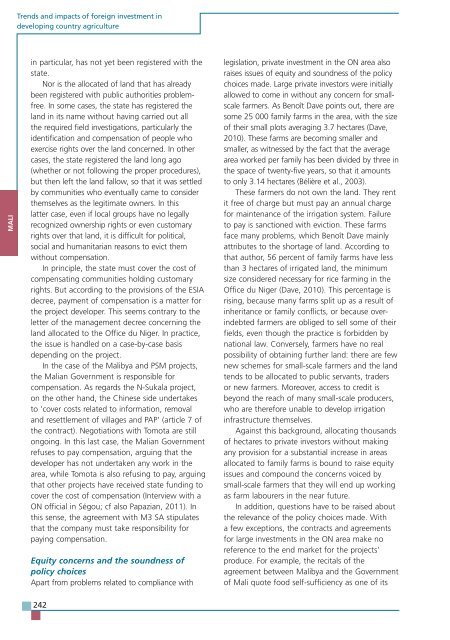TRENDS AND IMPACTS OF FOREIGN INVESTMENT IN DEVELOPING COUNTRY AGRICULTURE
TRENDS AND IMPACTS OF FOREIGN INVESTMENT IN DEVELOPING COUNTRY AGRICULTURE
TRENDS AND IMPACTS OF FOREIGN INVESTMENT IN DEVELOPING COUNTRY AGRICULTURE
Create successful ePaper yourself
Turn your PDF publications into a flip-book with our unique Google optimized e-Paper software.
MALI<br />
Trends and impacts of foreign investment in<br />
developing country agriculture<br />
in particular, has not yet been registered with the<br />
state.<br />
Nor is the allocated of land that has already<br />
been registered with public authorities problemfree.<br />
In some cases, the state has registered the<br />
land in its name without having carried out all<br />
the required field investigations, particularly the<br />
identification and compensation of people who<br />
exercise rights over the land concerned. In other<br />
cases, the state registered the land long ago<br />
(whether or not following the proper procedures),<br />
but then left the land fallow, so that it was settled<br />
by communities who eventually came to consider<br />
themselves as the legitimate owners. In this<br />
latter case, even if local groups have no legally<br />
recognized ownership rights or even customary<br />
rights over that land, it is difficult for political,<br />
social and humanitarian reasons to evict them<br />
without compensation.<br />
In principle, the state must cover the cost of<br />
compensating communities holding customary<br />
rights. But according to the provisions of the ESIA<br />
decree, payment of compensation is a matter for<br />
the project developer. This seems contrary to the<br />
letter of the management decree concerning the<br />
land allocated to the Office du Niger. In practice,<br />
the issue is handled on a case-by-case basis<br />
depending on the project.<br />
In the case of the Malibya and PSM projects,<br />
the Malian Government is responsible for<br />
compensation. As regards the N-Sukala project,<br />
on the other hand, the Chinese side undertakes<br />
to ‘cover costs related to information, removal<br />
and resettlement of villages and PAP’ (article 7 of<br />
the contract). Negotiations with Tomota are still<br />
ongoing. In this last case, the Malian Government<br />
refuses to pay compensation, arguing that the<br />
developer has not undertaken any work in the<br />
area, while Tomota is also refusing to pay, arguing<br />
that other projects have received state funding to<br />
cover the cost of compensation (Interview with a<br />
ON official in Ségou; cf also Papazian, 2011). In<br />
this sense, the agreement with M3 SA stipulates<br />
that the company must take responsibility for<br />
paying compensation.<br />
Equity concerns and the soundness of<br />
policy choices<br />
Apart from problems related to compliance with<br />
242<br />
legislation, private investment in the ON area also<br />
raises issues of equity and soundness of the policy<br />
choices made. Large private investors were initially<br />
allowed to come in without any concern for smallscale<br />
farmers. As Benoît Dave points out, there are<br />
some 25 000 family farms in the area, with the size<br />
of their small plots averaging 3.7 hectares (Dave,<br />
2010). These farms are becoming smaller and<br />
smaller, as witnessed by the fact that the average<br />
area worked per family has been divided by three in<br />
the space of twenty-five years, so that it amounts<br />
to only 3.14 hectares (Bélière et al., 2003).<br />
These farmers do not own the land. They rent<br />
it free of charge but must pay an annual charge<br />
for maintenance of the irrigation system. Failure<br />
to pay is sanctioned with eviction. These farms<br />
face many problems, which Benoît Dave mainly<br />
attributes to the shortage of land. According to<br />
that author, 56 percent of family farms have less<br />
than 3 hectares of irrigated land, the minimum<br />
size considered necessary for rice farming in the<br />
Office du Niger (Dave, 2010). This percentage is<br />
rising, because many farms split up as a result of<br />
inheritance or family conflicts, or because overindebted<br />
farmers are obliged to sell some of their<br />
fields, even though the practice is forbidden by<br />
national law. Conversely, farmers have no real<br />
possibility of obtaining further land: there are few<br />
new schemes for small-scale farmers and the land<br />
tends to be allocated to public servants, traders<br />
or new farmers. Moreover, access to credit is<br />
beyond the reach of many small-scale producers,<br />
who are therefore unable to develop irrigation<br />
infrastructure themselves.<br />
Against this background, allocating thousands<br />
of hectares to private investors without making<br />
any provision for a substantial increase in areas<br />
allocated to family farms is bound to raise equity<br />
issues and compound the concerns voiced by<br />
small-scale farmers that they will end up working<br />
as farm labourers in the near future.<br />
In addition, questions have to be raised about<br />
the relevance of the policy choices made. With<br />
a few exceptions, the contracts and agreements<br />
for large investments in the ON area make no<br />
reference to the end market for the projects’<br />
produce. For example, the recitals of the<br />
agreement between Malibya and the Government<br />
of Mali quote food self-sufficiency as one of its


